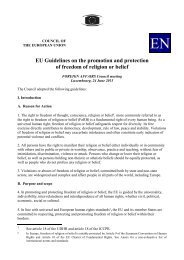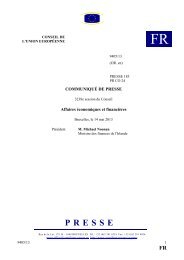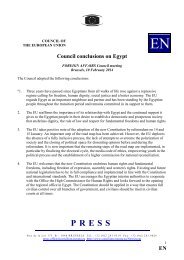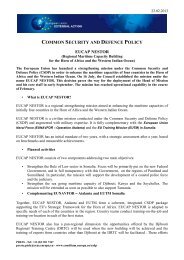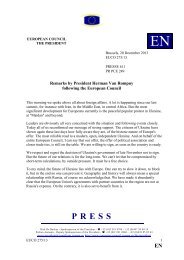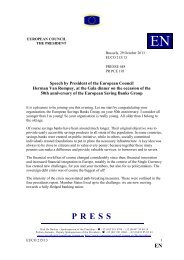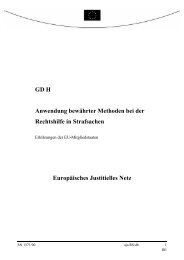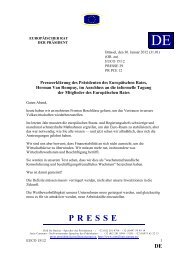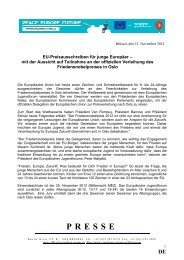14508/09 ADD 1 PL/vk 1 DG G COUNCIL OF THE ... - Europa
14508/09 ADD 1 PL/vk 1 DG G COUNCIL OF THE ... - Europa
14508/09 ADD 1 PL/vk 1 DG G COUNCIL OF THE ... - Europa
Create successful ePaper yourself
Turn your PDF publications into a flip-book with our unique Google optimized e-Paper software.
This means that a narrow gender pay gap may be connected to a modest total employment rate for<br />
women in some countries and a wider gender pay gap may be connected to a higher employment<br />
rate among women in other countries (see figure 4.6.15). The composition of the labour force is<br />
therefore important in explaining cross-country differences in the gender pay gap.<br />
Contrary to popular belief, women's lower educational qualifications and intermittent labour market<br />
participation are not the main reasons for the gender pay gap. The gap is in fact a visible symptom<br />
of factors such as the existence and persistence of gender stereotypes, occupational segregation and<br />
the wage structure. Women and men tend to work in different occupations and economic sectors,<br />
women are penalised for that, and men benefit. The extent of the penalty differs also depending on<br />
the wage structure; a more inequitable wage structure is likely to widen the gender pay gap and a<br />
compressed wage structure to diminish it.<br />
Today women have shorter periods of employment absence, and more women are found as<br />
managers and in high status occupations than before. However, at the same time wage differences<br />
in general are widening and there is a trend towards a more decentralised and individualised wage<br />
setting system. Over a longer period of time the pay gap has been narrowing in most countries, but<br />
there is no guarantee that this will be the case in future.<br />
4.6.4. Trends emphasised in Member States' reporting to the UNECE<br />
According to the MS reports to the UNECE, the important gender inequalities remain evident,<br />
especially as far as equal pay is concerned, where there is still a pay gap between women and men<br />
in all the MS; in some countries it is widening. Horizontally and vertically gender segregated labour<br />
markets and also connected to the gender pay gap, which also is a fact in all EU countries.<br />
As a major trend the employment rate of women has been increasing in the EU but remains lower<br />
than the employment rate of men. Several countries refer to the aim of increasing women's<br />
employment rate to 60 % by 2010. Hardly any report mentions men's declining employment rate.<br />
Women's prevalent part-time work, temporary employment and sexual harassment at work are<br />
mentioned by some MS.<br />
<strong>14508</strong>/<strong>09</strong> <strong>ADD</strong> 1 <strong>PL</strong>/<strong>vk</strong> 94<br />
ANNEX <strong>DG</strong> G EN



